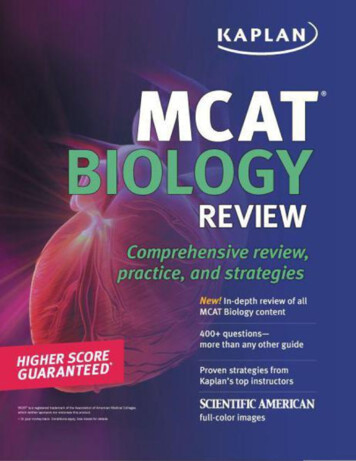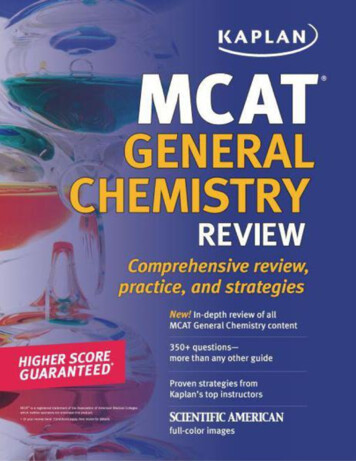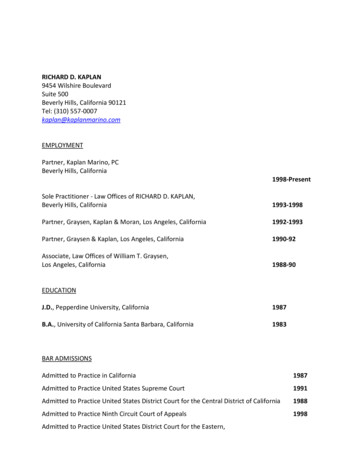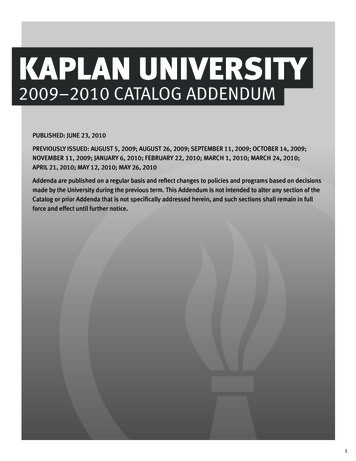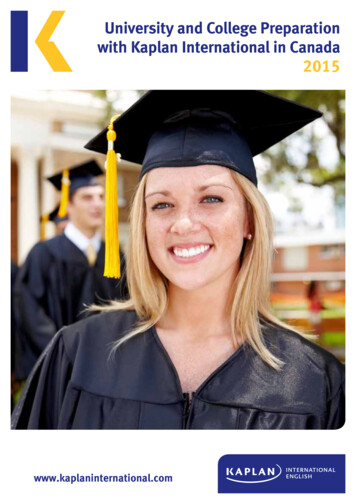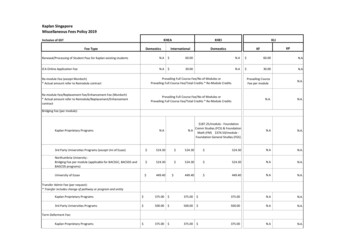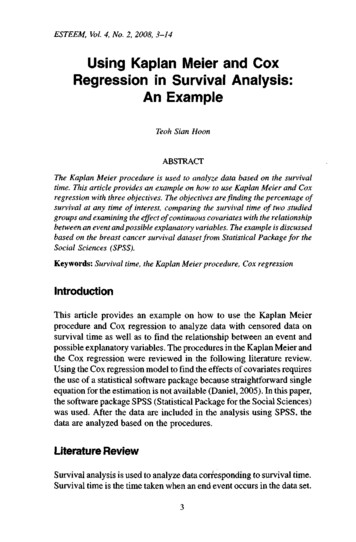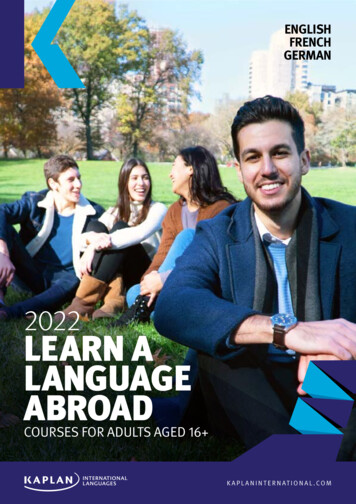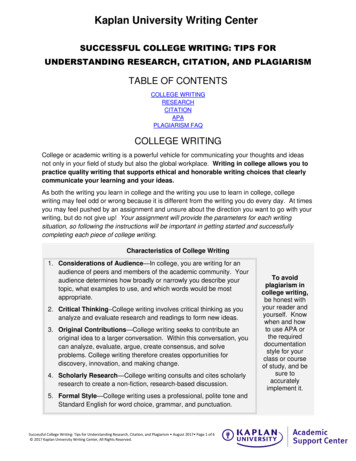
Transcription
Kaplan University Writing CenterSUCCESSFUL COLLEGE WRITING: TIPS FORUNDERSTANDING RESEARCH, CITATION, AND PLAGIARISMTABLE OF CONTENTSCOLLEGE WRITINGRESEARCHCITATIONAPAPLAGIARISM FAQCOLLEGE WRITINGCollege or academic writing is a powerful vehicle for communicating your thoughts and ideasnot only in your field of study but also the global workplace. Writing in college allows you topractice quality writing that supports ethical and honorable writing choices that clearlycommunicate your learning and your ideas.As both the writing you learn in college and the writing you use to learn in college, collegewriting may feel odd or wrong because it is different from the writing you do every day. At timesyou may feel pushed by an assignment and unsure about the direction you want to go with yourwriting, but do not give up! Your assignment will provide the parameters for each writingsituation, so following the instructions will be important in getting started and successfullycompleting each piece of college writing.Characteristics of College Writing1. Considerations of Audience—In college, you are writing for anaudience of peers and members of the academic community. Youraudience determines how broadly or narrowly you describe yourtopic, what examples to use, and which words would be mostappropriate.2. Critical Thinking–College writing involves critical thinking as youanalyze and evaluate research and readings to form new ideas.3. Original Contributions—College writing seeks to contribute anoriginal idea to a larger conversation. Within this conversation, youcan analyze, evaluate, argue, create consensus, and solveproblems. College writing therefore creates opportunities fordiscovery, innovation, and making change.4. Scholarly Research—College writing consults and cites scholarlyresearch to create a non-fiction, research-based discussion.5. Formal Style—College writing uses a professional, polite tone andStandard English for word choice, grammar, and punctuation.Successful College Writing: Tips for Understanding Research, Citation, and Plagiarism August 2017 Page 1 of 6 2017 Kaplan University Writing Center, All Rights Reserved.To avoidplagiarism incollege writing,be honest withyour reader andyourself. Knowwhen and howto use APA orthe requireddocumentationstyle for yourclass or courseof study, and besure toaccuratelyimplement it.
Kaplan University Writing CenterRESEARCHCollege writing assignments are designed to help you think critically, learn, and demonstrateyour learning. Using research allows you to advance your learning beyond common knowledgeand build on the ideas of others.Reading the works of others helps writers discover ideas and topics; collect details, data, quotations, and similar evidence; narrow your focus; craft a thesis; support or counter assertions, claims, and facts; develop your own perspectives on a topic; and select the most effective and relevant evidence from all you have read.Writers also use research in their writing to communicate professionally within their fields andacross the disciplines. Research-based college writing does not simply report others’ ideas andwords, but instead builds on them to demonstrate a writer’s understanding and credibility as anethical researcher, effective communicator, and critical thinker. However, creating an originalpiece of college writing while discussing the original ideas of others requires properintegration and citation of the research in your writing.Integrating ResearchThere are three ways to integrate research within college writing.1. Quoting: Using a source without altering it in any way—the work is used word for word. Itis critical that quotation marks enclose all directly quoted passages.2. Paraphrasing: Using a source by breaking it down and placing it in your own words—themeaning is extracted or restated in new wording and phrasing in just as many words orslightly more words than the original.3. Summarizing: Using a source by synthesizing many points or simplifying a long text into abrief synopsis in your own words.To avoid plagiarism when integrating research,cite all borrowed information in the body of the text where the borrowed information isbeing used and on a reference list at the end of the paper.Back to Table of ContentsSuccessful College Writing: Tips for Understanding Research, Citation, and Plagiarism August 2017 Page 2 of 6 2017 Kaplan University Writing Center, All Rights Reserved.
Kaplan University Writing CenterCITATIONCitation or citing sources means to include select information about books or articles you readon a topic and use in your paper. Citation is required when quoting, paraphrasing, or using theideas (artwork, photos, videos, etc.) or words of others. The two main terms associated withcitation, in-text citation and reference or full citation, are explained in this tutorial.Why We Cite1.2.3.4.5.Citation clearly differentiates original ideas from what information already existed.Citation grounds arguments in a field of study.Citation enables readers to locate your sources and additional information.Citation ensures ethical research and scholarly practice.Citation guarantees proper attribution of all ideas and avoids plagiarism.Why Plagiarism MattersPlagiarism deprives writers of the opportunity to join ongoing conversations about a topic. Itcompromises a writer’s integrity and reputation and usually results in serious consequences,both within the university and in the world of work.Back to Table of ContentsAPAAPA stands for the American Psychological Association. The Publication Manual of the AmericanPsychological Association establishes a national standard for the layout of an academic paper andgives a comprehensive method for referencing sources used in these types of papers.The Elements of an APA PaperThere are three major elements in an APAformatted paper:1. Manuscript format (header, margins,font, spacing, etc.),2. In-text citations, also calledparenthetical citations, and3. Reference citations, also calledbibliographic references, full citations, orthe reference list.Successful College Writing: Tips for Understanding Research, Citation, and Plagiarism August 2017 Page 3 of 6 2017 Kaplan University Writing Center, All Rights Reserved.
Kaplan University Writing CenterAPA In-Text CitationsIn-text citations are notations in the sentence of the paper where the research is being used.In APA style, these notations provide author and date information and in the instance ofquotes, also the page number. In-text citations take two common forms: as a signal phrasebefore the cited material or as a parenthetical citation at the end of the cited material. Signal phrase to cite a paraphrase: Smith (2010) recognized thatmore online learning opportunities are needed to reachmarginalized high school students and decrease the dropout rate. Signal phrase to cite a quote (Note the page number is added atthe end of the quote in a second set of parentheses): Smith (2010)stressed, “The importance of dedicated study time for onlinecourses is crucial for student success” (p. 3). Parenthetical citation for a paraphrase: Online learningopportunities are needed to reach marginalized high schoolstudents and decrease the dropout rate (Smith, 2010).Parenthetical citation for a quote: Many researchers agree:“Online education is a viable way to help working adults earn acollege degree, but it is not for everyone” (Smith, 2010, p. 4). No Author?If there is noindividual author,name thecorporate authoror sponsoringorganization:(NationalGeographic,2011, p. 78).If there is noindividual orcorporate author,use a shortenedversion of the titlefor the in-textcitation:No Year or Page Number?No year? Use n.d., short for “no date,” in the citation: (Sagorski, n.d.).No page number? Use the paragraph number. To determine theparagraph, begin at the title or heading and count the paragraphs to getto the one that contains your quote: (Sagorski, n.d., para. 4).(“Whales of theAtlantic,” 2010).APA Reference CitationsReference citations are listedon a separate page at the endof your paper and provide thefull bibliographic information foreach source cited in text(Figure 1). These citations tellwho the author is, when thepublication was, what the titleis, and where the source waspublished. In APA StyleCentral, you will find thespecifics for formattingreferences.Figure 1. Sample APA Reference ListBack to Table of ContentsSuccessful College Writing: Tips for Understanding Research, Citation, and Plagiarism August 2017 Page 4 of 6 2017 Kaplan University Writing Center, All Rights Reserved.
Kaplan University Writing CenterPLAGIARISM FAQWhat is Kaplan University’s official policy on plagiarism?Kaplan University's official policy on plagiarism is available in the University Catalog. See theAcademic Integrity Policy for details.What is the difference between accidental and intentional plagiarism?Accidental plagiarism may result from improperly using or inaccurately citing a source, whileintentional plagiarism is knowingly using a source without proper citation or any citation. Bothaccidental and intentional plagiarism can be prevented with proper credit of the borrowedinformation, but both accidental and intentional plagiarism also have the same consequencesof plagiarism. See the Academic Integrity Policy for details.What is self-citation?While original work is expected for each course and each assignment, there are instanceswhen it is appropriate for a student to build on ideas from a previous assignment by citinghimself or herself. You may therefore cite small selected portions of previous work in a newwork using the appropriate citation method. Note: Copying large portions or entireassignments for use in more than one course or academic assignment is considered cheatingand is not permitted. See the Kaplan University Self-Citation Policy for details.What is the Student Reuse Policy?The Student Reuse Policy allows students who are retaking a Kaplan Course after a failedattempt to reuse previous course work with proper citation and advance notice to theinstructor. Read the Student Reuse Policy in the Academic Integrity Policy for details andstipulations. Note: This policy does not apply to Concord Law students.What about programs that automatically format papers according to APA standards?Most automatic formatting programs and citation generators rely heavily on the users’ ability toplug in information correctly; therefore, these types of tools should be used sparingly andcautiously and usually only after the user has a basic understanding of APA style. The WritingCenter recommends APA Style Central, which has templates for APA formatting.What about images? Do I need to cite pictures, tables, or charts in my papers?Like other types of research, visuals such as photographs, tables, or charts borrowed orcopied directly from a source have to be cited both in the text and on a reference list. On theother hand, if you use your own photography in your paper, you will not need to cite it. Forborrowed images, however, the source of the image must be credited in a caption with acopyright statement adjacent to the image and in a corresponding reference citation. Forexamples of citations for images, refer to The APA Style Blog here or the Writing Center guideon citing images here.Successful College Writing: Tips for Understanding Research, Citation, and Plagiarism August 2017 Page 5 of 6 2017 Kaplan University Writing Center, All Rights Reserved.
Kaplan University Writing CenterWhat about common knowledge?Unless taken word for word from a source, there are specific times when content that is notoriginally yours does not need to be cited. Certain characteristics must be met for content tobe considered common knowledge: The same information can be located in a minimum of five different research sources.Your reader should already know this information.The information is easily accessible in general information sources.The information comes from folklore, mythology, or well-known stories.The facts are well known in your field of study—and will be well known to your audience.If you take a well-known fact word for word from a source, a citation is required to attributethe wording to the source and to avoid plagiarism, and if you use another writer’s interpretationof common knowledge, that writer needs to be cited, as the interpretation is not commonknowledge or original to your writing. Additionally, statistics require citation becausestatistical information is not typically equally represented in general information sources; thesource of the statistic, either as a primary or secondary source, needs to be cited.You might not know if something is common knowledge until you find it explained the sameway in several sources, so it's best to cite it like you normally would until you adequately proveto yourself that it is common knowledge.How can the Writing Center help me with APA and avoiding plagiarism?You can access the Writing Center from the KU Campus or Kaplan homepage by clicking “MyStudies” then “Academic Support Center.” The Writing Center offers multiple modes ofassistance for all Kaplan University students:1. Writing Tutor: You may speak with a live tutor Sunday through Thursday during specifiedhours.2. Q and A: You may submit a writing question 24 hours using the submission form. You willreceive a response within 24 hours on weekdays or 48 hours on weekends.3. Paper Review Service: You can submit an entire essay for feedback. While this is not aplagiarism detection service or a guarantee of higher grades, tutors can help youunderstand areas of your work that need attention. Submit papers using the submissionform. Replies normally take 48 to 72 hours.4. Writing Reference Library: You will find writing guides in the form of webpages,documents, videos, interactive tutorials, and podcasts that offer specific help with writing.5. Webinars: You can attend live writing workshops during specified times, or you canbrowse and watch recorded workshops, or download workshop resources.Back to Table of ContentsSuccessful College Writing: Tips for Understanding Research, Citation, and Plagiarism August 2017 Page 6 of 6 2017 Kaplan University Writing Center, All Rights Reserved.
There are three major elements in an APA- formatted paper: 1. Manuscript format(header, margins, font, spacing, etc.), 2. In-text citations, also called parenthetical citations, and 3. Reference citations, also called bibliographic references, full citations, or the reference list.

